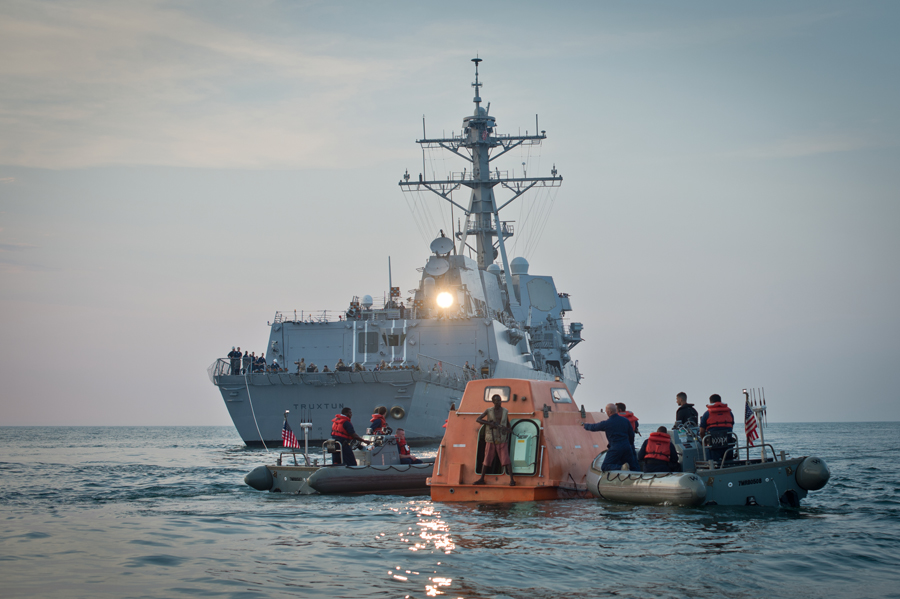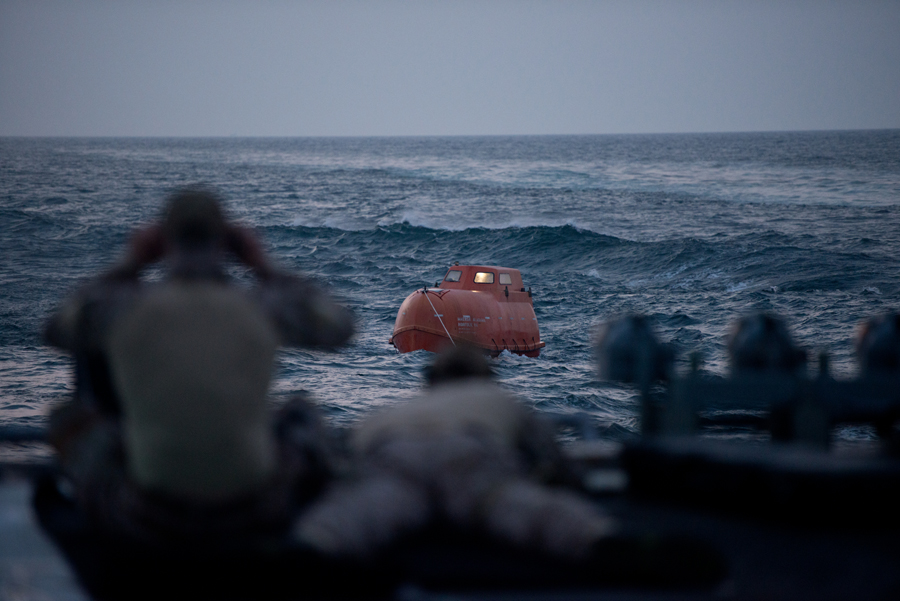The World as It Is and Is To Be Expected
The Found Footage of Captain Phillips

In April 2009, four Somali pirates hijack the cargo ship Maersk Alabama in the Indian Ocean. Captain Richard Phillips surrenders as a hostage and is taken away by the pirates in a lifeboat. A large-scale American military operation ensues in which Phillips is rescued. Three of the Somali pirates die and the fourth, Abduwali Muse, is arrested. Muse is sentenced in America and is currently serving his sentence of 33 years and 9 months in an American prison.
A year later Phillips publishes the book A Captain’s Duty: Somali Pirates, Navy SEALs, and Dangerous Days at Sea in which he relates his version of the facts. Sony Pictures buys the rights to the book. A year after its publication Paul Greengrass, known for Bloody Sunday (2002) The Bourne Supremacy (2004) and United 93 (2006), amongst other films, assumes the direction of the film adaptation and Tom Hanks agrees to take on the role of Captain Phillips. Appropriate Somali actors are found in Minneapolis and, in order to reconstruct the ship exactly, the producers visit the original lifeboat which is exhibited at the National Navy UDT-Seal Museum.
Filming starts on the 26th of March 2012 and most of it takes place off the coast of Malta. For nine weeks the crew films on the Maersk Alexander, a ship identical to the Maersk Alabama. On the 21st of September 2013, Richard Phillips and Tom Hanks appear together on the cover of the American magazine Parade. The film premières on the 11th of October 2013 at the New York Film Festival, in the presence of Hanks, Phillips, crew members of the Maersk Alabama and uniformed U.S. Navy personnel. The captain seems pleased with the end result and the film enjoys a standing ovation at the festival.

Captain Phillips is an unbelievably thrilling film. For two hours we follow the developments of this dramatic incident with clammy hands, sitting on the edge of our seats as we await the fate of the captain. As a viewer one breathes a sigh of relief when the Navy SEALs appear on the scene and rescue Phillips.
Captain Phillips is an unbelievably loathsome film. Loathsome because it confirms in an utterly gruesome way how our contemporary world works.
What do we get to see in the film? And in particular, how does Greengrass try to tell his story? The film was shot in an excessively ‘realistic’ style: shaky camera, in the midst of the action, edited quickly and with limited analysis. The fiction doesn’t create any distance from the actual events. On the contrary, the film puts everything into effect in order to create a feeling of ‘look, we were there’, this is how it ‘really’ happened. The film achieves the status of a re-enactment: the facts are meticulously simulated. Greengrass points this out himself: “When we started the film, it was a top priority for me to look into this issue in every detail. […] we researched the background of the Maersk Alabama hijacking in exhausting detail over many […] And I’m 100% satisfied that the picture we present of these events in the film, including the role playing by Captain Phillips, is authentic. […] the facts are clear. Captain Phillips’ ship was attacked, and the ship and the crew and its cargo made it safely to port with no injuries or loss of life. […] That’s the story we told, and it's an accurate one.”1 Greengrass apparently saw it as his duty to make the film correspond as accurately as possible to the historical facts given on the operation. The world in the film must strive to be as close as possible to this historical truth. And why? Because a film like Captain Phillips is founded on these true facts; ‘authenticity’ is its imperative keyword. But what is Greengrass’ true endeavour with this claim of ‘authenticity’?
This type of fiction has, in a certain sense, taken over the impossible idea of an objective documentary. Greengrass wants his film to only be determined by the facts and not by his own or others’ judgements or prejudices. But does objectivity here not simply mean representing the world like the viewer (or society) expects to see it?
Depending on what characters are being filmed, a different texture, colour and camera technique is used. The majority of shots of Hanks and his crew are filmed on 35mm in a balanced colour palette. Somalia and the pirates are filmed with the grubby (or should we say: dated?) format of 16mm. The look becomes dirtier, yellower and more flares appear on screen. When the U.S. Navy makes its appearance, Greengrass uses gliding helicopter shots and desaturated colours. Why were these choices made? Why must a formal distinction be made here?
In a certain sense, the naturalistic claim of Captain Phillips goes even further than that of the cinéma vérité, a movement from the sixties which was concerned with a truthful and objective representation of reality. Here we can distinguish a wholly different form of naturalism. Greengrass depicts the world not only ‘as it is’, but especially ‘as it is to be expected’. Yet here too, a sense of objectivity persists. Everything is geared towards making us forget that the product we get to see is a film, a composition with a chosen form. But this filmic strategy doesn’t only engineer the forgetting of the form or the immersion in the spectacle. We are so used to these kinds of images that we can no longer unmask them as a composition. Every narrative element has received the form which preceding films or documentaries assigned to it. Somalia looks like what we expect Somalia to look like. And the four pirates? Well yes, there’s an aggressive one, a young and nervous rascal, a leader and one who knows how to sail the boat. Even the film’s proportion of spectacle seems to have become a requisite element of the objectively envisioned representation of the event.
Inevitably the question must be asked: why was this film made? The only answer one can give to this question is highly cynical: because that’s just the way the world works, and especially because that’s the way we have learnt and want to look at the world. The film is propaganda for a world which manifests itself as unchangeable.
Yet some politically correct cracks show themselves throughout the overall texture of the film. In one scene, the heroic captain confronts a pirate with his current career choice and suggests that there must be other options for him in life. The pirate replies sharply: “Only in America, Irish, only in America.” This dialogue in itself reveals the complete cultural and economic deadlock. In an utterly impoverished Somalia, the American dream no longer appears as a desirable dream-image, but rather as straightforward perversion. Nevertheless, these cracks in the armour of the film remain merely politically correct set dressing. Greengrass thus shows himself capable of detecting the possible issues of the film. He knows that a purely dramatic unfolding of the events, in the generally accepted and here better developed Hollywood form, would simply be distasteful. But is it not much more distasteful to literally and consciously degrade the political engagement to the periphery? The film remains a product of its time. The film is not overtly pro- or anti-American. This is as much true of a film like Zero Dark Thirty (2012) in which the American director Kathryn Bigelow also sought to reconstruct the events mentioned as accurately as possible: “Those of us who work in the arts know that depiction is not endorsement. If it was, no artist would be able to paint inhumane practices, no author could write about them, and no filmmaker could delve into the thorny subjects of our time.”2 Greengrass and Bigelow claim not to be dogmatic, but are so all the more. They claim that this is reality and that what they portray has the status of an historical truth. Surely a director, conscious of their form and their specific standpoint, can provide more insight and truth about our world? Making a film always amounts to choosing a form. That this form is concealed by images we are familiar with does not make this choice less present, but only less visible.
A possible response to this claim is that in other Hollywood productions the ‘outside world’ – that part of the globe which does not geographically comprise the American sphere – is not represented at all. That films such as Captain Phillips and Zero Dark Thirty, which bring a story about the present-day world, are therefore laudable. And indeed, such films do tend to become cultural occasions. World-renowned philosophers of culture and distinguished film critics write responses and trigger a social debate about the American perspective on their own history, on the statute of torture and their perspective and position towards the ‘other’. The impact, focus and clarification of these problems are yet minimal. Was a new conceptual framework really offered to the viewer after having watched these films? Do not these films confirm the old frameworks yet again? Is there ultimately a difference between a film like Captain Phillips and Superman?
An event – anchored in a geopolitical and complex humanitarian problem – takes place four years ago. In Hollywood the news is cynically enough received with a certain joy. Greengrass confirms this himself: “Firstly, it was just a fantastic modern crime story. I loved that it was real-world pirates as opposed to cuddly Hollywood pirates, and I loved that it was a film that felt ripped from the headlines but you go into it in a way that you can’t get from the news.”3 The creators can’t be reproached that they invented this story, since truly, it is indeed based on true facts. The logical state of affairs appears to be that subsequently a couple of ‘top’-screenwriters, a ‘top’-cameraman, a ‘top’-director and a ‘top’-actor are appointed and that hopefully the film can quickly (quickly!) be manufactured in order for viewers to witness the tragedy. Before we know it, we enter the cinema for two hours of inconspicuous, technically accomplished ‘top’-entertainment.
The film ends. Barely four years ago, three Somali pirates were killed and one Somali pirate ended up in an American prison 12,000 kilometres from home. When Hollywood, the biggest film production machine in the world, tells a story of Somali fishers/pirates, they have to struggle once again with the power of the established order and its form. One can only conclude that that is the way of the world: the world as it is and is to be expected.
- 1“I am Paul Greengrass, director of Captain Phillips, The Bourne Ultimatum, and various other films. AMA.”.
- 2Kathryn Bigelow, “Kathryn Bigelow ‘Zero Dark Thirty’ torture criticism”.
- 3Sharon Waxman, “‘Captain Phillips’ Director Paul Greengrass Explains Why the Closing Scene With Tom Hanks Was So Authentic”.
Images (1) and (2) from Captain Phillips (Paul Greengrass, 2013)

